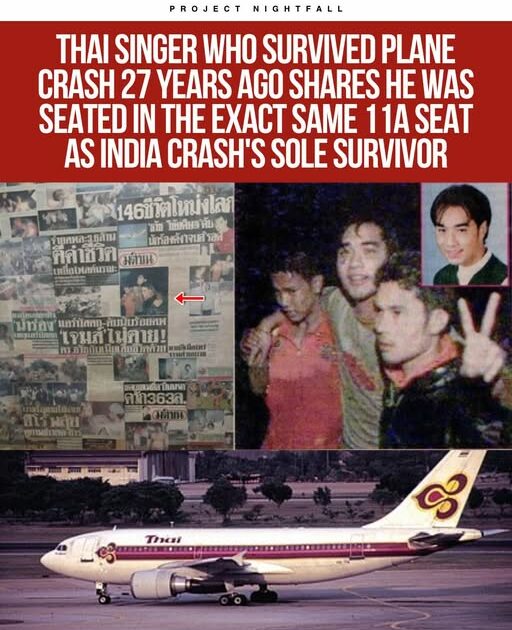In a remarkable twist of fate, a Thai singer, Ruangsak Loychusak, found himself reliving a harrowing past when news broke of the sole survivor of an Air India crash occupying the same seat he had in a similar tragedy decades earlier. Loychusak, now 47, survived the 1998 crash of Thai Airways flight TG261, a disaster that claimed 101 lives. The plane, en route to Surat Thani from Bangkok, stalled mid-air and crashed into a swamp, leaving Loychusak marked by the traumatic experience. Learning that the only survivor of the recent Air India 787 Dreamliner crash, British national Vishwash Kumar Ramesh, was also seated in 11A, sent chills down Loychusak’s spine. He took to social media to express his shock and offer condolences, recalling the long-lasting emotional and physical scars he endured after his own brush with death.
Loychusak’s survival in 1998 marked the beginning of what he calls his “second life,” a life initially shadowed by the trauma of the crash. For a decade following the incident, he struggled with a fear of flying, experiencing difficulty breathing even in normal air pressure. He confessed to avoiding conversation during flights, preferring to stare out the window, a constant reminder of his vulnerability. The crash imprinted itself on his senses: the deafening sound of the impact, the acrid smell of burning debris, and even the taste of the swamp water. These sensory memories haunted him for years, triggering intense emotional distress whenever he encountered dark clouds or rainstorms. The singer revealed that he carried the weight of these memories silently, a testament to the profound impact of the near-death experience.
The recent Air India tragedy mirrored Loychusak’s experience in a chillingly similar manner. The Boeing 787 Dreamliner, destined for London Gatwick from Ahmedabad, met a fiery end shortly after takeoff. Of the 244 souls on board, only Ramesh, a 40-year-old from Leicester, England, survived. The aircraft reportedly exploded upon impact with buildings, leaving a scene of devastation. Ramesh, miraculously ejected from the disintegrating plane before the explosion, recounted the horrifying moments leading to the crash. He described a sudden descent immediately after takeoff, followed by the plane splitting apart, which propelled him out of the aircraft.
Ramesh, despite sustaining multiple injuries, remained conscious throughout the ordeal. He described witnessing two cabin crew members perish before his eyes, adding a layer of profound sadness to his own survival. His seat, situated near the emergency exit, detached upon impact, a circumstance that may have been instrumental in saving his life. He recalled the pilots’ desperate attempts to control the plummeting aircraft, but ultimately, it crashed into a building with devastating force. The subsequent explosion engulfed the plane in flames, scorching Ramesh’s arm. Disoriented and surrounded by debris and bodies, he managed to escape the burning wreckage, a moment captured in videos showing him hobbling away from the scene.
Ramesh’s account provided a glimpse into the chaos and terror of the crash. He described the scene he encountered upon regaining his footing: bodies scattered amidst the wreckage, a grim reminder of the immense loss of life. Overwhelmed by fear, he ran from the scene until someone assisted him into an ambulance, transporting him to a hospital in Ahmedabad. The medical team, led by Dr. Dhaval Gameti, confirmed his stable condition despite the severity of his injuries. Ramesh’s survival against all odds, coupled with the eerie coincidence of the shared seat number with Loychusak, underscored the unpredictable nature of such catastrophic events.
The shared experience of these two survivors, separated by decades and different airlines, highlights the profound psychological impact of surviving a plane crash. While the physical injuries may heal, the emotional scars can linger for years, shaping the survivors’ lives in unexpected ways. Loychusak’s decade-long struggle with his fear of flying and Ramesh’s harrowing account of the Air India crash serve as stark reminders of the enduring trauma associated with such events. Their stories resonate with a shared sense of disbelief and gratitude for a second chance at life, a life indelibly marked by the shadow of a near-death experience. The coincidence of seat 11A adds another layer of mystery to these tragedies, a chilling reminder of the capricious nature of fate.


